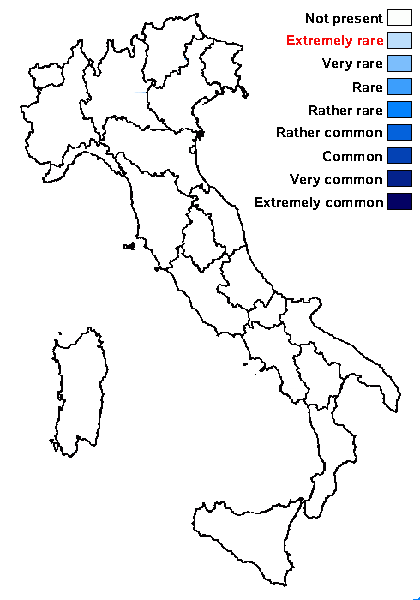Leptosillia acerina (Rehm) Voglmayr & Jaklitsch
in Voglmayr& al., Persoonia, 42: 242, 2019. Basionym: Leptorhaphis acerina Rehm - Ber. naturhist. Augsburg, 26: 51, 1881
Synonyms: Cresporhaphis acerina (Rehm) M.B. Aguirre; Metasphaeria robergia Schulzer & Sacc.
Distribution:
Description: Thallus inapparent, not lichenized, developing on cork wings of Acer campestre. Perithecia black, shiny, half-immersed, (0.1-)0.14-0.2(-0.24) mm across, smooth, scattered singly, subglobose to hemispherical, circular from above, often collapsed and then appearing cupulate, with a central apical papilla. Exciple continuous, of a textura angularis, composed of an outer dark brown, 12–24 μm thick layer of thin-walled cells with dark brown walls, and an inner, 12–16 μm thick hyaline to pale brown layer of (sub)hyaline cells. Paraphyses hyaline, smooth, thin-walled, septate, occasionally branched, 2-3 μm wide, embedded in a gelatinous matrix reacting I-; periphyses not observed. Asci 8-spored, cylindrical, thin-walled. Ascospores 1-celled, hyaline, falcate, (21-)24-30(-32) x (2.5-)2.8-3.2(-3.5) μm, thin-walled, with subacute, tapering ends, often minutely guttulate. Pycnidia scattered, black, slightly smaller than perithecia. Conidia 1-celled, hyaline, falcate, (23-)26-29(-32) x (1.9-)2.0-2.4(-2.7) μm, often guttulate. Photobiont absent. Spot tests: all negative. Chemistry: without lichen substances.Note: on cork wings and outgrowths (rhytidome) of living or dead branches of Acer campestre, known from Austria, Croatia and Germany, to be looked for in Italy.
Growth form: Fungus
Substrata: bark
Reproductive strategy: mainly sexual
Pioneer species

Predictive model

Source: Voglmayr H., Aguirre-Hudson M.B., Wagner H.G., Tello S., Jaklitsch W.M. 2019. Lichens or endophytes? The enigmatic genus Leptosillia in the Leptosilliaceae fam. nov. (Xylariales), and Furfurella gen. nov. (Delonicicolaceae). Persoonia, 42: 228–260. - CC BY-NC-ND 3.0
Leptosillia acerina. a–b. Perithecia on bark (right ascoma in a. laterally collapsed, in b. horizontally collapsed and cupulate); c. side view of perithecium
with apical papilla; d. paraphyses; e–f. asci; g. ascus tip in Lugol; h–r. vital ascospores; s. pycnidia in culture (CMD, isolation plate, 40 d); t–u. conidiophores,
conidiogenous cells and conidia from pycnidia on natural substrate; v–c1. conidia from natural substrate; d1–f1. conidia from pycnidia in culture (CMD, isolation
plate, 21 d). All in water, except where noted (a–b: WU 39995 (epitype); c, g, m–r, t–c1: WU 39998; d–f, h–l: WU 39997; s: CRA; d1–f1: CRA3). — Scale
bars: a–c = 100 μm; d–f, t–u = 10 μm; g–r, v–f1 = 5 μm; s = 500 μm.
Growth form: Fungus
Substrata: bark
Reproductive strategy: mainly sexual
Pioneer species

Predictive model

 INDEX FUNGORUM
INDEX FUNGORUM
 GBIF
GBIF

